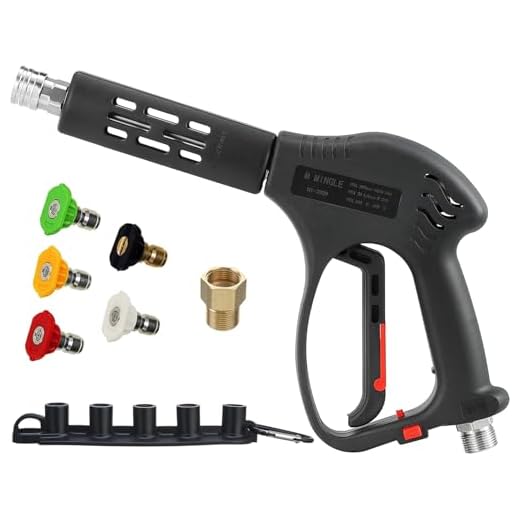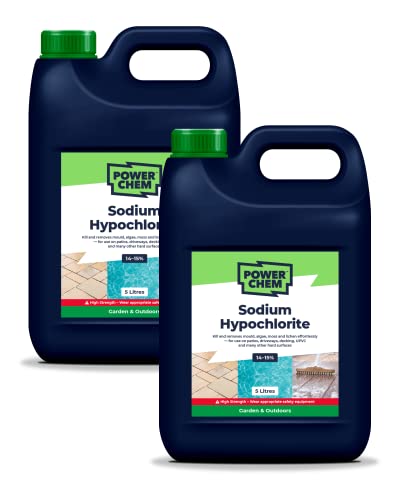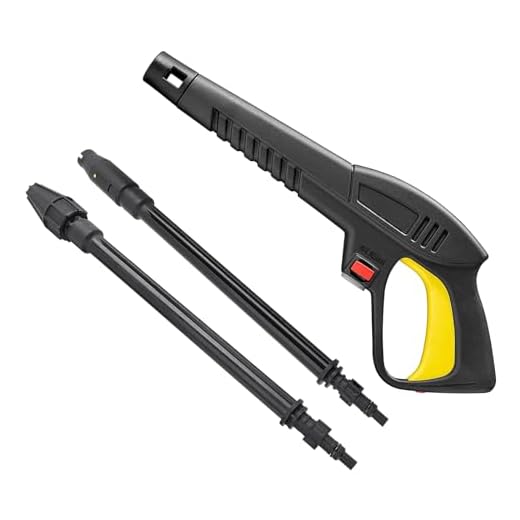



To effectively clean your vehicle, I recommend using a 25-degree fan in combination with a cleaning solution. This angle balances pressure and coverage, ensuring thorough removal of dirt without damaging the paintwork. The softer spray will not strip wax or clear coat, making it a reliable choice for automotive surfaces.
If you need to tackle tougher grime, consider switching to a 15-degree option, which concentrates the water stream. However, exercise caution, as this increased intensity can potentially harm sensitive areas. Always test in a discreet spot first to ensure your vehicle’s finish remains intact.
For pre-soaking and overall rinsing, employing a soap attachment can enhance the cleaning process. This not only allows for better dirt penetration but also improves the effectiveness of the cleaning solution, making your task easier and more efficient.
In my extensive experience with various brands and models, I have consistently found that selecting the right angle can dramatically influence cleaning results. Pay attention to the manufacturer’s guidelines for your equipment to maximise performance while safeguarding your vehicle’s finish.
Recommendations for Nozzle Selection
For cleaning vehicles, I recommend using a 25-degree fan attachment. This choice strikes a balance, providing sufficient force to remove dirt without risking damage to paintwork or sensitive components. The medium spray pattern avoids the concentrated power of narrower options that can harm delicate surfaces.
When tackling stubborn grime, a rotating or turbo attachment can be beneficial. This type offers a spinning spray, effectively lifting dirt while minimising the risk of scratches. It’s particularly useful for wheels and lower panels where debris tends to cluster.
Here’s a quick reference table to clarify the best options:
| Attachment Type | Recommended Use | Notes |
|---|---|---|
| 25-Degree Fan | General cleaning | Safe for paintwork; versatile |
| Rotating/Turbo | Heavy stains and dirt | Effective for tough spots; use cautiously |
| 40-Degree Fan | Gentle rinse | Best for final rinse; very safe |
Additionally, always remember to maintain a safe distance. I suggest keeping the nozzle at least 2 feet from the surface to prevent any potential for damage. Regularly inspect the equipment for wear and tear to ensure optimal performance during each use.
Understanding the Different Nozzle Types for Car Washing
For optimal results, a 25-degree or 40-degree attachment works best. These provide a balance between cleaning power and safety, preventing damage to the vehicle’s surface.
The 25-degree variant delivers a concentrated spray that effectively removes dirt while being gentle enough for the paintwork. In contrast, the 40-degree version spreads the water over a wider area, which is ideal for rinsing off soap and ensuring a thorough finish.
Specialised tips like foam cannon attachments can enhance the process by producing thick foam that clings to the surface, allowing for a more effective pre-wash. When using such accessories, ensure the detergent is compatible with the equipment.
Always remain at a distance of at least 2 feet from the surface to prevent any potential damage, regardless of the used head. Monitoring the conditions such as sunlight and wind is also crucial, as they can impact drying and water removal effectiveness.
Switching between these tools during the cleaning process can yield better results, combining both focused cleaning for tough spots and broad coverage for rinsing. Adapting your approach based on the vehicle’s condition will result in a better shine and overall appearance.
How to Choose the Right Nozzle Size for Your Pressure Washer
For optimal cleaning results, select a nozzle that matches the cleaning task. Generally, a wider angle provides a gentler spray for delicate surfaces, while a narrower angle delivers a concentrated jet for tougher grime.
Understanding Nozzle Sizes
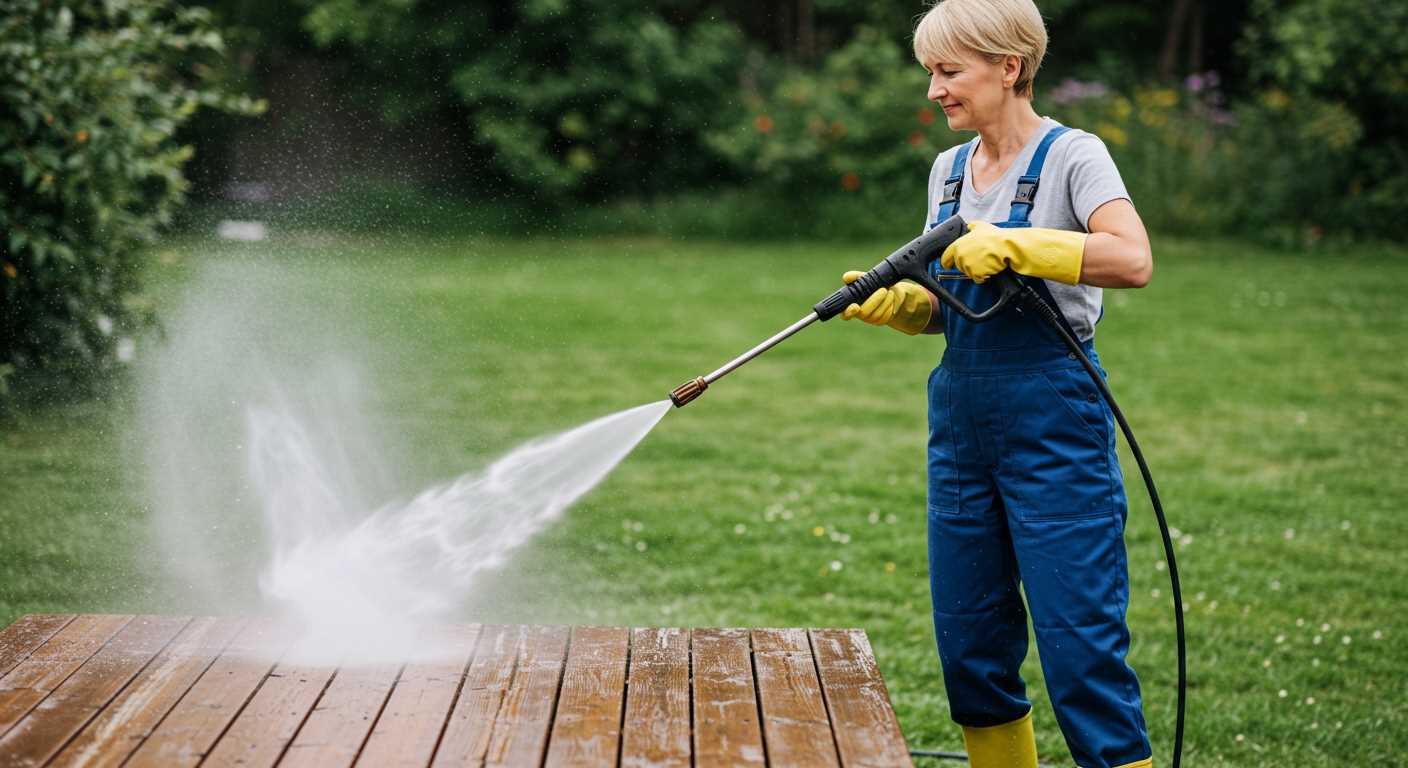
- 25 degrees: Ideal for general cleaning, this size works well on moderate dirt levels and larger areas.
- 15 degrees: Suitable for heavy-duty applications, especially on persistent stains, but take care to avoid damage on softer surfaces.
- 40 degrees: Best for gentle cleaning jobs, such as rinsing or washing sensitive areas, where precision is necessary.
Tips for Selecting the Right Size
- Assess the surface material. Softer materials need a wider angle to prevent damage.
- Consider the level of dirt. Heavily soiled areas may require a narrow angle, while lighter cleaning can benefit from a wider approach.
- Test different sizes. Experimenting with various angles allows you to find the most efficient option for specific tasks.
Choose nozzles based on these factors to enhance cleaning efficiency and protect surfaces from potential harm. Always start with the least aggressive option and adjust as necessary.
Benefits of Using a Foam Cannon Nozzle for Pre-Washing
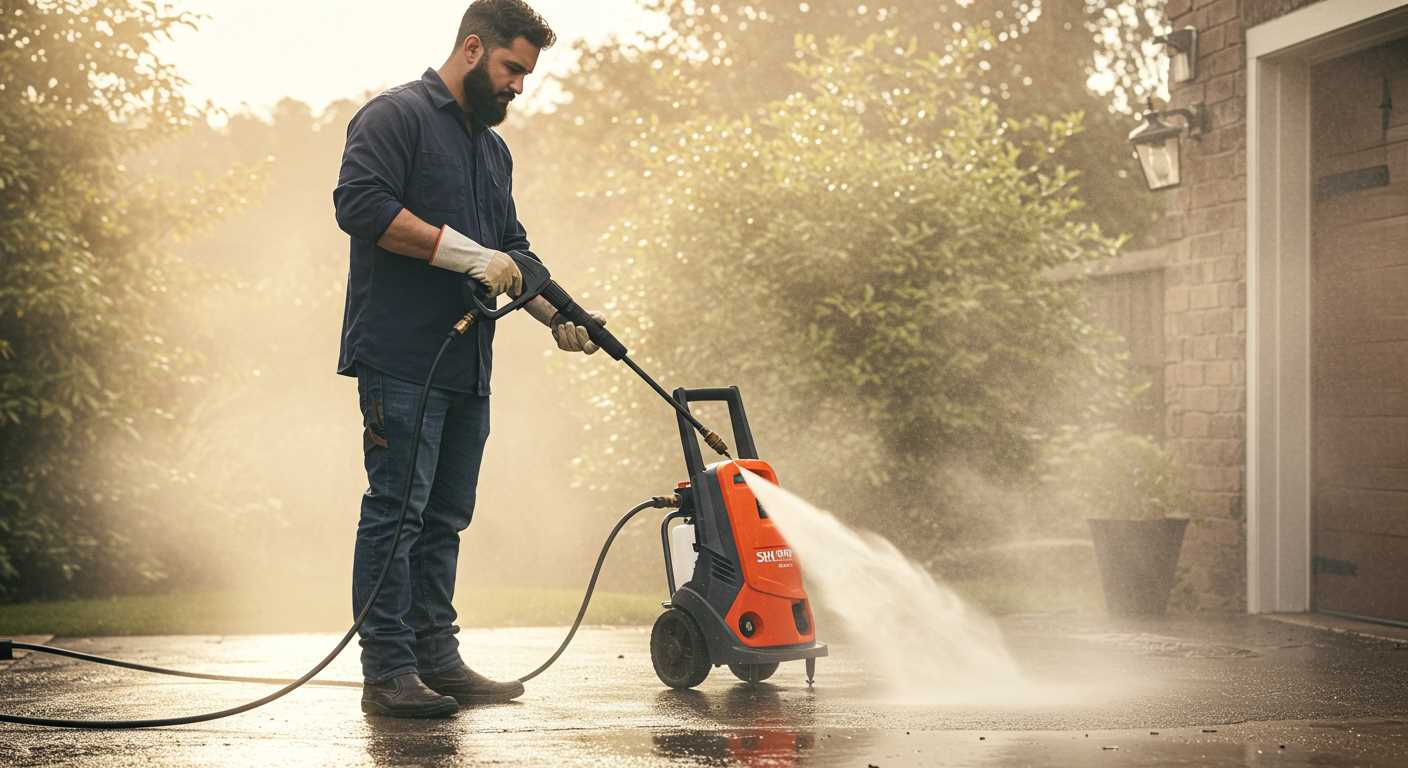
Utilising a foam cannon attachment offers numerous advantages during the initial cleaning phase. The primary benefit is the ability to evenly distribute a thick layer of foam across the surface. This foam clings better to the exterior, maximising contact time with dirt and grime, allowing for more effective loosening of contaminants.
One of the standout features of foam cannons is their compatibility with various cleaning agents. You can choose specific solutions designed for different finishes. This flexibility enhances the cleaning process, catering to the unique needs of your vehicle’s surface, from paint to glass.
Enhanced Cleaning Power
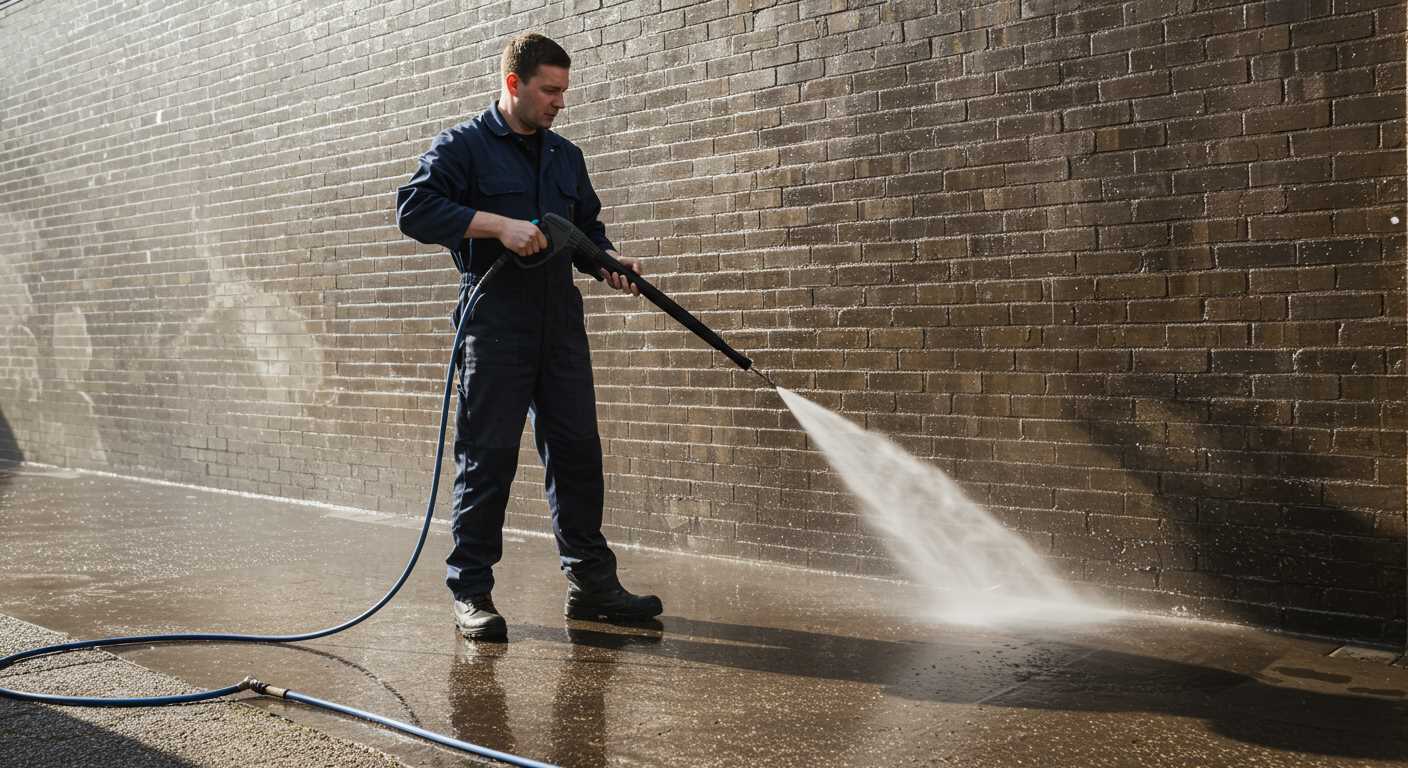
Foam enhances the cleaning power significantly. It envelops particulates, reducing the risk of scratches during the rinsing phase. By pre-soaking the exterior with foam, the removal of stubborn dirt is much easier, saving time and effort.
Water Conservation
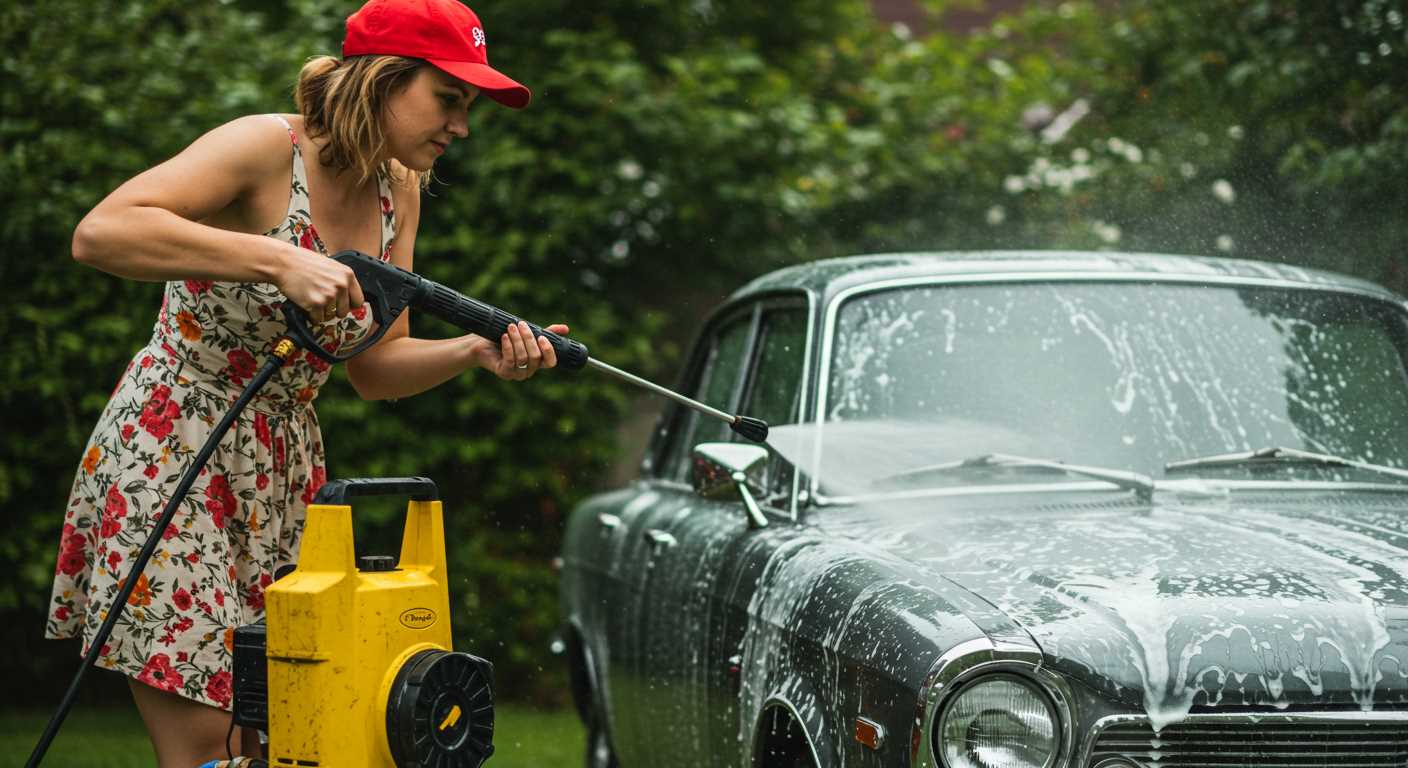
This method proves to be more water-efficient compared to traditional techniques. The dense foam allows for less rinsing time, resulting in saved water. Additionally, the need for frequent refilling is diminished, making it a more environmentally friendly choice.
Incorporating a foam cannon into your routine certainly elevates your cleaning game. The combination of effective cleaning and practical benefits justifies its use for anyone serious about maintaining their vehicle’s appearance.
When to Use a 15-Degree Nozzle for Stubborn Dirt
A 15-degree attachment is ideal for addressing persistent grime and tough stains. This angled tip produces a concentrated stream of water, providing the necessary force to break down and dislodge caked-on debris.
Utilise this specific attachment when your vehicle bears baked-on mud or oily residues from long road trips. It’s especially effective on wheel wells and undercarriages where contaminants accumulate stubbornly.
Before applying the 15-degree head, ensure you take necessary precautions. Always maintain a safe distance from the surface–around 12 to 18 inches is generally advisable–to prevent damage to paint or other delicate finishes. Pre-treat the area with a suitable cleaning agent to enhance results and lessen scrubbing effort.
After the application, inspect the area for any missed spots. You may want to go over stubborn areas in a slow, sweeping motion to ensure the highest cleaning efficiency. In some instances, a follow-up with a milder attachment might be necessary to achieve a final polish.
This strong stream can strip wax and protective coatings, so consider reapplying wax or sealant after the cleaning to restore your vehicle’s shine and protection. The proper use of this attachment will help maintain the aesthetics and longevity of your automobile’s surface, ensuring it looks its best for years to come.
Precautions to Take When Using a Pressure Washer Nozzle on Cars
Before starting the cleaning process, ensure you wear appropriate personal protective equipment, including safety goggles, gloves, and sturdy footwear. This protects against any debris or chemicals that may be displaced during cleaning.
Begin by rinsing the surface with low water flow to remove loose dirt and debris. This reduces the risk of scratches from dirt being forced into the paintwork. Maintain a distance of at least 2 to 3 feet from the vehicle’s surface, especially when using high-pressure settings. A closer distance can cause damage to paint and finish.
Check the Surface
Inspect the vehicle’s body for any existing scratches or dents. Using high pressure on damaged areas can exacerbate the issue. Additionally, be cautious around sensitive areas such as window mouldings, trim, and decals, as they may not withstand strong jets of water.
Avoid cleaning in direct sunlight or on hot surfaces to prevent soap from drying too quickly and leaving residue. Work in shaded conditions or during cooler times of the day for optimal results.
Use the Right Technique
Always use sweeping motions rather than concentrated blasts on any section. This allows for even cleaning and minimizes the risk of damaging the car’s surface. Start from the top and work your way down to ensure that dirt flows off rather than being pushed into clean areas.
Ensure that all connections are secure before operating the equipment to prevent leaks and potential injuries. Be mindful of your surroundings to avoid accidents, especially around children or pets. Following these precautions will help achieve a thorough clean without compromising the vehicle’s appearance.
Tips for Maintaining Nozzles for Optimal Performance
Regular cleaning of the tips is non-negotiable. After each session, rinse them thoroughly to remove any debris or chemicals that could cause clogs.
Always check for signs of wear or damage. Cracks, chips, or bending can significantly alter the spray pattern and efficiency. Replace any faulty tips immediately for consistent performance.
Store tips separately in a protective pouch to prevent physical damage. Avoid keeping them in the main compartment with other tools to reduce the risk of scratching or impact.
Periodically examine the connectors and seals. A tight fit is essential to prevent leaks. If you notice any water escaping, replace the seals to maintain pressure and effectiveness.
Consider using a degreaser periodically to remove any stubborn deposits. This can help maintain the integrity of the nozzle and ensure optimal flow at all times.
Be mindful of the water source. If your water supply contains a high level of minerals, it may cause calcification inside the tips. Using a water softener can prolong their lifespan.
Lastly, always refer to the manufacturer’s guidelines for specific maintenance instructions. Adhering to these can greatly enhance the longevity and performance of your cleaning accessories.
FAQ:
What pressure washer nozzle should I use for car washing?
For washing your car, it is recommended to use a nozzle with a wide spray angle, typically a 25-degree or 40-degree nozzle. These nozzles provide a gentler spray that is effective at removing dirt and grime without damaging the car’s paint. The lower the degree, the more concentrated the pressure, which can be too harsh for car surfaces.
Can I use a narrow angle nozzle for washing my car?
Using a narrow angle nozzle, such as a 0-degree or 15-degree nozzle, can lead to potential damage. These nozzles produce a concentrated stream of water that, while effective for tough stains on hard surfaces, can harm the paintwork and finish of your vehicle. It’s best to stick to wider angle nozzles for car washing.
What is the ideal pressure setting for washing a car?
The ideal pressure setting for washing a car is generally between 1200 and 1900 PSI (pounds per square inch). This pressure range is sufficient to remove dirt and debris without risking damage to the car’s paintwork. Always start with a lower pressure and adjust as needed, making sure to use a suitable nozzle for the best results.
Are there any special nozzles for washing cars?
Yes, there are special purpose nozzles designed specifically for washing cars. These can include foam cannon attachments that allow you to apply a thick layer of car shampoo, ensuring even coverage and effective dirt removal. Additionally, there are soft wash nozzles that can create a gentle mist, perfect for delicate finishes.


